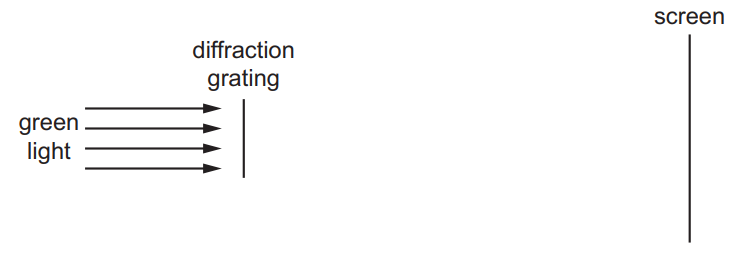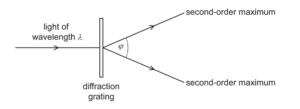Question
Light of a single wavelength is incident normally on a diffraction grating.
The resulting diffraction pattern is displayed on a screen.
Which change makes the first orders of intensity maxima further apart from each other on the screen?
A placing the screen closer to the diffraction grating
B using a diffraction grating with less separation between adjacent slits
C using a diffraction grating with more slits but keeping the same separation between adjacent slits
D using light with a shorter wavelength
Answer/Explanation
Ans:
Question
Green light is incident normally on a diffraction grating and forms a diffraction pattern on a distant screen.

Which change, on its own, would decrease the separation of the diffraction maxima on the screen?
A Increase the distance between the screen and the diffraction grating.
B Replace the diffraction grating with a grating that has a smaller separation between the slits.
C Replace the diffraction grating with a grating that has fewer slits per unit length.
D Replace the green light with red light
Answer/Explanation
Ans :
Question
Light of a single unknown wavelength and blue light of a single wavelength are both incident
normally on a diffraction grating. Two diffraction patterns are produced, one for each wavelength
of light.
The third-order maximum for the blue light occurs at the same angle as the second-order
maximum for the light of unknown wavelength. The wavelength of the blue light is 480 nm.
What is the unknown wavelength?
A 320 nm
B 720 nm
C 960 nm
D 1440 nm
Answer/Explanation
Ans:
Question
A parallel beam of white light passes through a diffraction grating. Orange light of wavelength
600 nm in the fourth-order diffraction maximum coincides with blue light in the fifth-order
diffraction maximum.
What is the wavelength of the blue light?
A 450 nm B 480 nm C 500 nm D 750 nm
Answer/Explanation
Question
Light of wavelength λ is incident normally on a diffraction grating, as shown.

The angle between the two second-order maxima is ϕ.
Which expression gives the spacing of the lines on the diffraction grating?
A \(\frac{\lambda }{sin\theta }\) B \(\frac{\lambda }{\left ( sin\theta /2 \right )}\) C \(\frac{2\lambda }{sin\theta }\) D \(\frac{2\lambda }{sin\left ( \theta /2 \right )}\)
Answer/Explanation
Ans:
